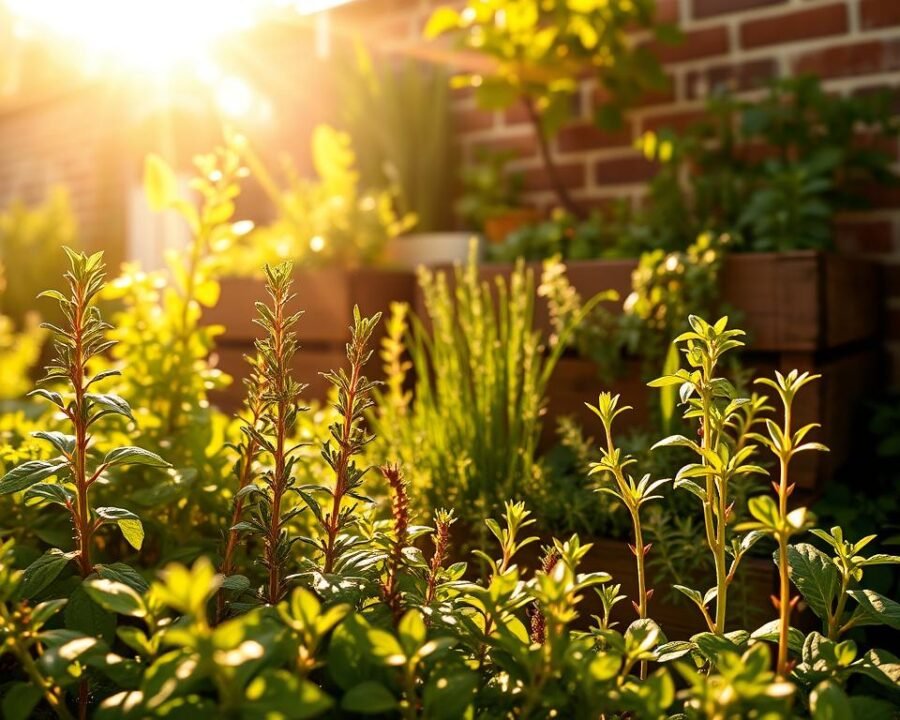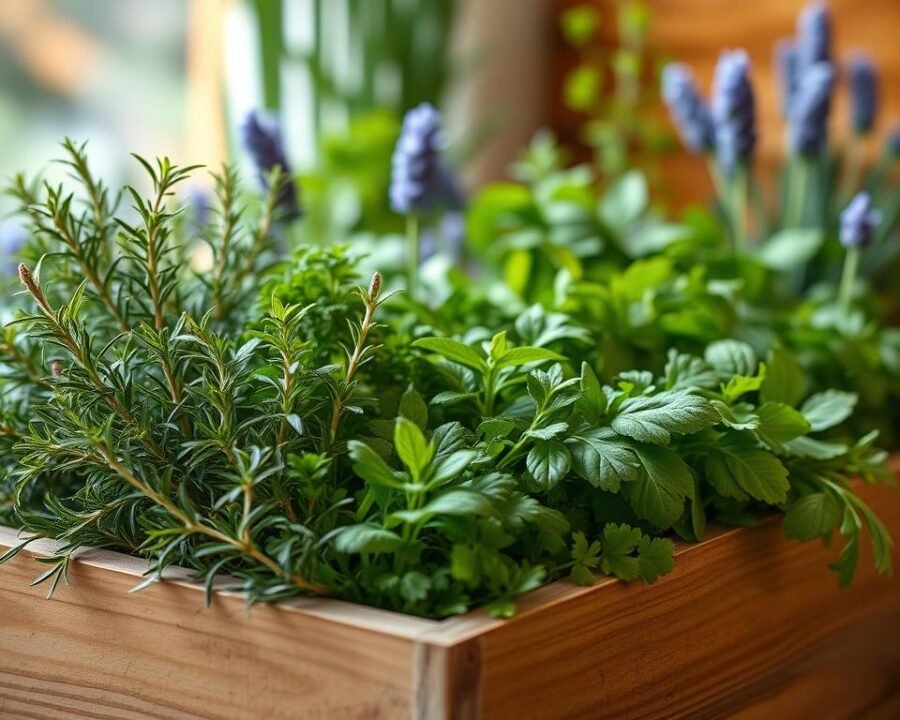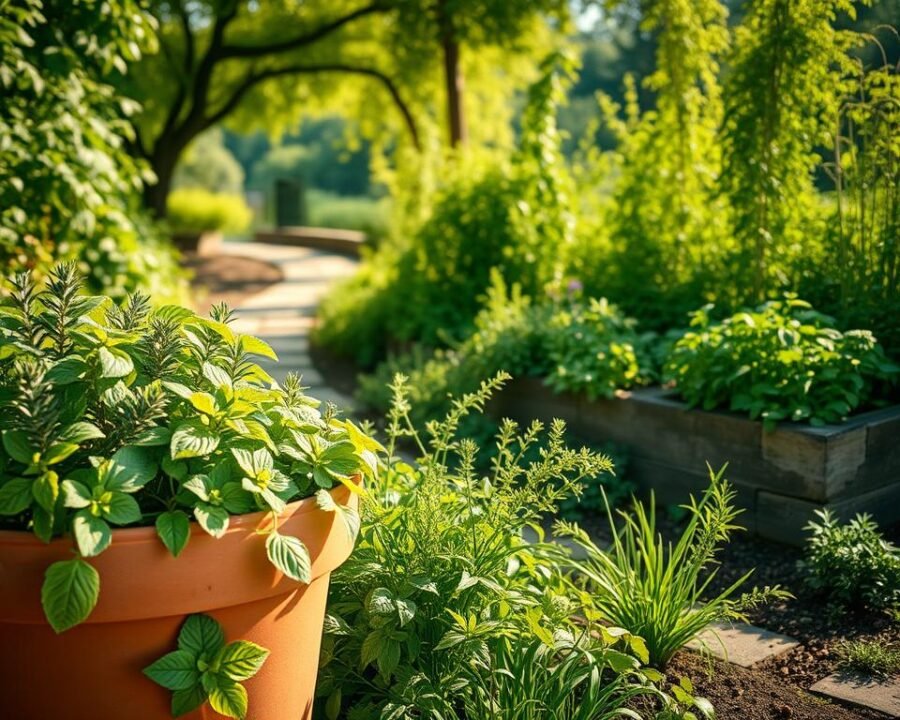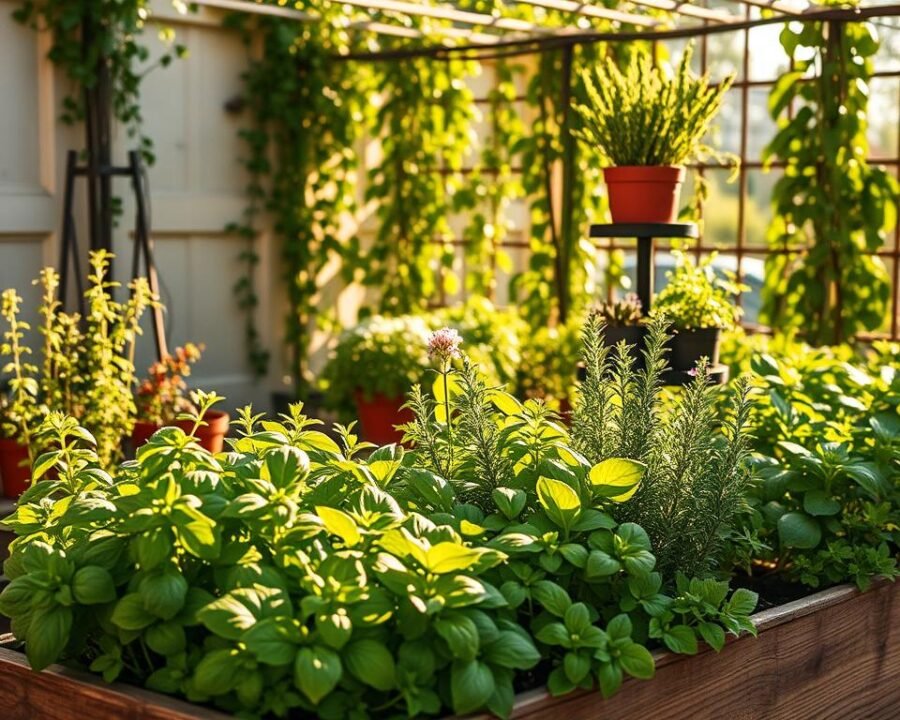Discover the Best DIY Herb Garden You Need to Try
There’s something magical about plucking fresh herbs from your own garden. Whether it’s basil for pasta or mint for tea, homegrown flavors make every dish special. Even in small spaces like patios or balconies, a thriving herb garden is possible.
Starting simple with low-maintenance options like chives builds confidence. No need to rely on store-bought bundles—just snip what you need right away. The joy of nurturing plants goes beyond the kitchen, offering a peaceful escape.
With clever setups like vertical planters or window boxes, anyone can grow fresh herbs year-round. Imagine stepping outside to harvest rosemary for dinner—it’s that easy. Let’s explore how to bring this vibrant, aromatic world into your home.
Key Takeaways
- Small spaces like balconies work perfectly for growing herbs.
- Begin with easy-to-grow varieties like chives for quick success.
- Fresh homegrown herbs beat store-bought in flavor and convenience.
- Vertical or container setups maximize limited areas.
- Tending plants offers relaxation and a rewarding hobby.
Why Grow Your Own Herb Garden?
Fresh flavors right at your fingertips—that’s the magic of cultivating plants at home. Beyond convenience, homegrown options bring unmatched quality and sustainability to everyday cooking.
Benefits of Fresh Herbs at Home
Nothing compares to the vibrant taste of just-picked leaves. Commercial options often lose potency during transport, while home cultivation preserves volatile oils for richer flavors.
Consider these advantages:
- 40% cost savings compared to store-bought bundles
- Zero pesticide residue (USDA found chemicals on 78% of commercial samples)
- 90% less plastic waste than supermarket packaging
Basil demonstrates the value perfectly. One $3 plant yields $60 worth of leaves annually. That’s twenty times the return with minimal effort.
Cost-Effective and Sustainable Gardening
Herb cultivation shines in resource efficiency. These plants require 30% less water than vegetable plots while offering continuous harvests.
| Factor | Homegrown | Store-Bought |
|---|---|---|
| Annual Cost (Basil) | $3 | $60 |
| Carbon Footprint | 0.2 lbs CO2 | 5.4 lbs CO2 |
| Water Usage | 12 gallons | 28 gallons |
Communities amplify these benefits through plant swaps. Sharing cuttings with neighbors creates variety without extra cost. Imagine swapping rosemary for thyme—everyone wins.
Summer recipes come alive when combining three or more varieties. Try mixing mint, basil, and oregano for Mediterranean-inspired dishes bursting with freshness.
How to Create the Best DIY Herb Garden You Need to Try
Location and conditions make all the difference for healthy, flavorful plants. Whether indoors or outside, matching herbs to their ideal environment ensures robust growth and rich flavors.

Choosing the Right Location
Mediterranean herbs like rosemary crave 6–8 hours of direct sun. South-facing windows work best for indoor setups. For urban spaces, try sun mapping—track light patterns over a day to find the brightest spots.
Microclimates matter too. Balconies with wind protection or shaded corners suit delicate varieties. Pairing herbs with marigolds naturally deters pests without chemicals.
Sunlight and Soil Requirements
Healthy soil is the foundation. Heavy clay? Mix in 30% grit for better drainage. Test pH with household items: vinegar (alkaline) or baking soda (acidic) create bubbles in unbalanced soil.
| Factor | Outdoor | Indoor |
|---|---|---|
| Sun Exposure | 6–8 hours direct | South-facing window |
| Soil Type | Amended with compost | Lightweight potting mix |
| Drainage | Raised beds | Pots with holes + coffee filters |
For tight space, go vertical. Hanging planters or stacked container systems save room. A DIY self-watering system with plastic bottles keeps water consistent—perfect for busy growers.
Selecting the Perfect Herbs for Your Garden
With countless varieties available, picking the perfect herbs can feel overwhelming. Focus on growth habits, light needs, and flavor profiles to build a balanced collection. Whether you crave zesty basil for sauces or earthy rosemary for roasts, each plant brings unique rewards.

Easy-to-Grow Herbs for Beginners
Start with forgiving varieties like basil, yielding ½ cup of leaves weekly. Parsley thrives with minimal care, while mint adds vigor—but plant it in containers to curb its 12″ annual spread.
- ‘Spicy Globe’ basil: Compact and pest-resistant
- Curly parsley: Mild flavor, ideal for garnishes
- Peppermint: Perfect for teas (use solo pots)
Mediterranean Herbs for Sunny Spots
Sun-loving rosemary survives -10°F with mulch, while thyme and oregano flourish in rocky, dry soil. These drought-tolerant stars need:
| Herb | Sun Exposure | Special Care |
|---|---|---|
| Rosemary | Full sun | Prune after flowering |
| Oregano | 6+ hours | Trim to prevent legginess |
Shade-Tolerant Herbs
Chives and cilantro excel in dappled light. For continuous harvests, sow dill every 3 weeks. These adapt to:
- North-facing balconies
- Under tree canopies
- Indoor LED grow lights
Pair cilantro with quick-growing microgreens for layered flavors. Just avoid overcrowding—give each plant space to breathe.
Setting Up Your Herb Garden
Getting started with growing fresh flavors at home involves choosing the right setup. Whether in containers or directly in the ground, each method has unique benefits. Let’s explore the best approach for your space and lifestyle.

Container vs. Ground Planting: Pros and Cons
Potted plants offer flexibility, especially for small areas. They require watering every couple of days but have a 30% higher success rate for beginners. In-ground planting reduces watering frequency by 40%, making it ideal for low-maintenance gardening.
Consider these factors:
- Cost: A $5 DIY wine crate outperforms $30 store-bought planters.
- Drainage: Layer pebbles at the bottom of pots with holes to prevent root rot.
- Space: Taproot herbs like rosemary need deeper soil, while basil thrives in shallow setups.
“Recycled materials like pallets or colanders add charm while being eco-friendly.”
Step-by-Step Planting Guide
Begin with quality seeds or starter plants. Follow these steps for thriving growth:
- Prepare the soil: Mix compost for in-ground beds or use lightweight potting mix for containers.
- Plant strategically: Space cilantro 6″ apart and dill 12″ apart to avoid overcrowding.
- Water wisely: Keep soil moist but not soggy—finger-test the top inch.
For transplant shock prevention, acclimate plants gradually. Start with 2 hours of outdoor exposure, increasing daily. Companion planting boosts yields—try basil with tomatoes or chives with roses.
Discover more herb-growing techniques to refine your setup. Whether upcycling boots as planters or using a 2’x4′ grid, creativity maximizes results.
Caring for Your Herb Garden
Healthy growth depends on consistent watering and smart pruning. With a few simple habits, plants thrive year-round, offering fresh flavors for every season.
Watering and Feeding Tips
Overwatering causes 65% of failures. Use the finger-test—insert a finger up to the second knuckle. If soil feels dry, it’s time to hydrate.
Homemade fertilizers boost nutrients. Try banana-peel tea: steep peels in water for 48 hours, then dilute 1:4. Seaweed feed increases yields by 25%.
Pruning and Preventing Overgrowth
Trim yellow leaves to redirect energy. For bushier growth, snip stems above leaf nodes. Pruning rosemary in dormancy improves growth by 40%.
- Harvest mint weekly to control spread.
- Divide chive clusters every spring.
“Strategic cuts encourage new growth—think of it as a haircut for plants.”
Seasonal Maintenance
In summer, shade delicate leaves during peak heat. Winter dormancy requires less light—move pots to east-facing windows.
| Season | Task |
|---|---|
| Spring | Repot root-bound plants |
| Fall | Apply mulch for insulation |
Clean tools with vinegar to prevent disease. A little care ensures herbs like basil and thyme flourish for your family’s meals.
Harvesting and Using Your Homegrown Herbs
The true reward of growing herbs comes when it’s time to harvest. Those vibrant leaves hold flavors no store can match. With proper techniques, we extend their freshness from kitchen to table.
Best Practices for Picking Herbs
Timing matters—morning harvests preserve 30% more essential oils. Use sharp scissors for clean cuts above leaf nodes. This encourages new growth while keeping plants productive.
Different herbs need distinct approaches:
- Basil: Pinch stems just above leaf pairs
- Rosemary: Cut 4″ sprigs from woody branches
- Mint: Harvest whole stems to control spread
For continuous yields, never remove more than ⅓ of a plant. Regular picking actually boosts production in varieties like oregano and thyme.
Creative Ways to Use Fresh Herbs in Cooking
Beyond garnishes, herbs transform everyday meals. Infuse olive oil with rosemary for roasted potatoes. Blend basil into fruit salads for surprising flavor twists.
Preservation locks in freshness:
| Method | Duration | Best For |
|---|---|---|
| Freezing in oil cubes | 6 months | Parsley, chives |
| Herb vinegars | 12+ months | Tarragon, thyme |
| Dehydrating | 1 year | Oregano, sage |
For gifts, bundle dried lavender into sachets or create custom tea blends. Community swaps let you share unique varieties while expanding your own gardens.
“A windowscreen drying rack costs under $5 but yields months of seasoning.”
Pair flavors thoughtfully—dill elevates fish, while sage complements pork. In drinks, muddled mint or basil adds refreshing complexity. Every harvested leaf brings new possibilities.
Conclusion
Growing fresh flavors at home brings joy and savings. Studies show a 92% stress reduction among growers, plus an average $87 return on a small $15 investment. From that first sprout to abundant harvests, every step rewards effort.
Share progress with local groups or online communities. Advanced methods like hydroponics offer year-round growth, even in tight space. Starter kits make it easy to begin right away.
Fresh-picked leaves elevate meals while cutting costs. Whether for family meals or gifting, homegrown options deliver quality. Join the movement—transform any corner into a thriving green spot.







